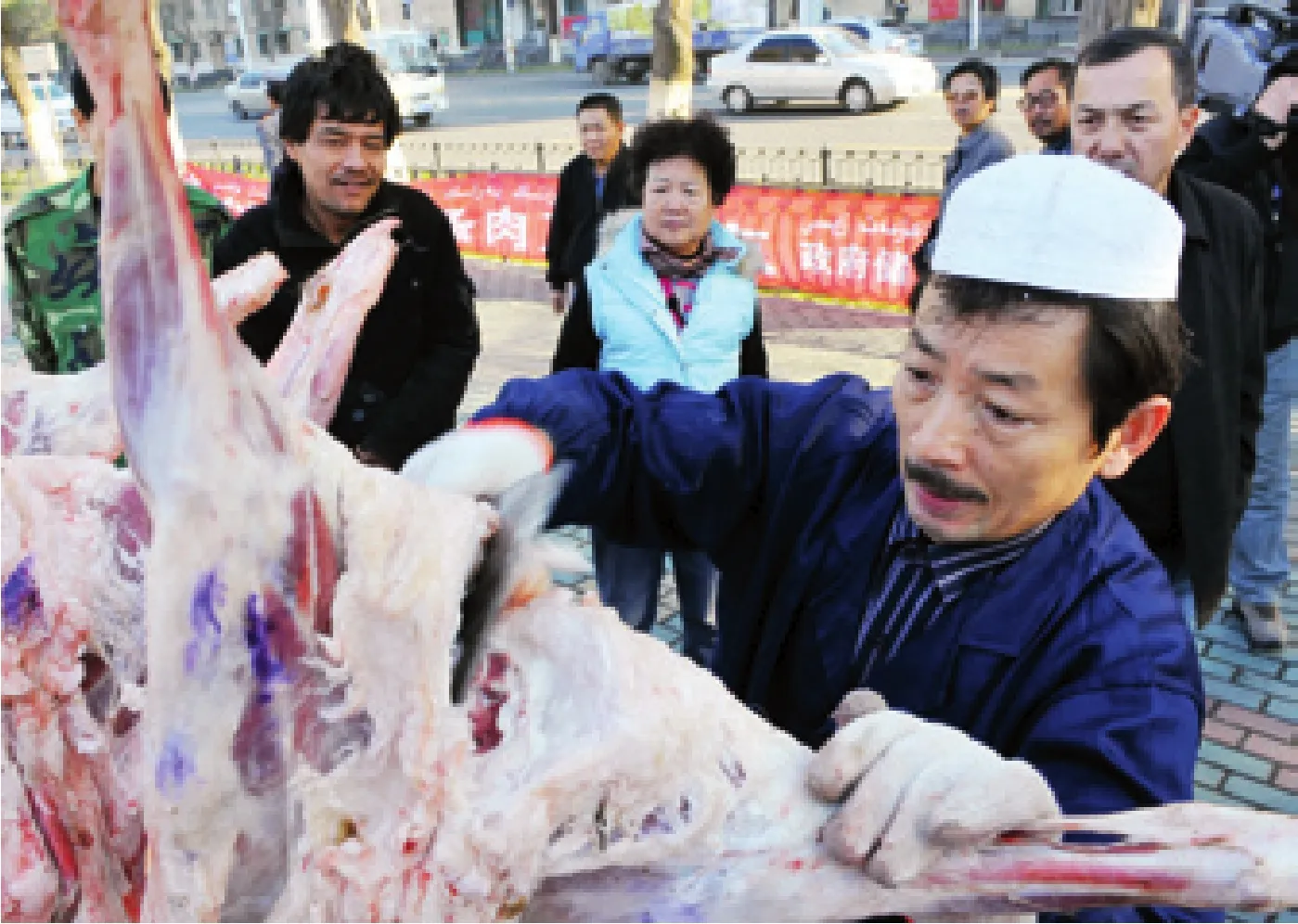Inflation Returns
2010-10-14ByLIUYUNYUN
By LIU YUNYUN
Inflation Returns
By LIU YUNYUN
Striking a balance between econom ic prosperity and inflation remains a problem for China

CHILLY PRICES: Now that w inter has a rrived, food p rices, espec ia lly vege tab le p rices in superm arkets ac ross China, are soaring
B efore being able to catch its breath follow ing two strenuous years of policy implementation following the global slowdown, the Chinese economy finds itself up against another challenge:inflation. Just as it did three years ago, consumer inflation, on everything from garlic and food to diapers and non-perishables, is plaguing the Chinese mainland.
The consumer price index (CPI), a barometer for inflation, soared 4.4 percent year on year in October, the highest in almost two years, mostly driven by increases in food prices. The inflation rate is expected to increase further in the last two months of this year due to a low comparison base in 2009.
The prices of daily necessities have been rising since China’s 4-trillion-yuan ($586-billion) stimulus plan was put in place in November 2008. Some goods, pushed up by massive cash injection and possible speculation, have seen their prices surge above precrisis levels.
As usual, food is being singled out as the culprit for the rising prices. In Xinfadi,Beijing’s largest vegetable, fruit and grain transaction center, rice was sold at 1.6 yuan($0.24) per kg last w inter. This year, the price has almost doubled to 3 yuan ($0.45)per kg.
Some fam ilies are even m issing the months follow ing the financial crisis, when the prices of food, housing and autos had settled at relatively affordable levels after months of increasing. The previous round of inflation started in early 2007 and continued until the outbreak of the financial crisis in 2008.
A lready, some people in Shenzhen,Guangdong Province, are traveling to nearby Hong Kong to buy soy sauce, eggs and other daily necessities since Hong Kong food prices are noticeably cheaper.
The price of staple food, such as wheat and rice, jumped more than 10 percent in October from the previous few months.New s of a food crunch—in mung beans,garlic and sugar—has dominated Chinese newspaper headlines this year. And reports of food smuggling, hoarding and profi teering have stoked public anger and caught the attention of the Central Government.
The Chinese central bank raised both the benchmark loan and deposit interest rates by 0.25 percentage points on October 20, the first increase in three years. In spite of the hike, the real interest rate in China is still in negative territory, dim inishing the value of citizens’ savings in commercial banks.
The latest China Quarterly Update issued by the World Bank China Office on November 3 said inflation, pushed up by higher food prices, may stay above the 3-percent target for a while and is unlikely to escalate as core inflation remains in check.However, the update contended raw commodity prices m ight rise further. Sustained high wage grow th, w hile unlikely, also cannot be ruled out. Given the fundamental drivers of property prices—rampant liquidity and peop le’s desire for better living conditions—the property sector is unlikely to be contained for long. On current trends and policies, the external surplus is on course to rise in 2011 and in the medium term.
The cause
There’s simply too much cash in the market, said Xie Guozhong, an independent econom ist and a director at Rosetta Stone Capital Ltd. Xie argued the market supply has always remained stable, so the root cause for surging prices is oversupply of money.
At a government work meeting earlier this year, Chinese Prem ier W en Jiabao pledged to stick to a “moderately loose”monetary policy throughout 2010 for fear the then-fragile recovery would come to an abrupt end if the stimulus measures were pulled.
“The central bank has adopted an extremely loose monetary policy,” said Wu Xiaoling, Vice Chairman of the Financial and Econom ic Comm ittee of the Standing Comm ittee o f the National Peop le’s Congress. “Our seemingly robust economic grow th in the past three decades was actually built upon excess money supply.”
The quantitative easing monetary policies adopted by some major econom ies add pressure to China’s efforts in battling inflation,according to the 2010 Third Quarter China Macro-Econom ic Situation Analysis published by the central bank on October 27. The U.S. Federal Reserve said on November 3 that it would buy up an additional $600 billion in long-term Treasury bonds by the end of June 2011 as part of its quantitative easing strategy to support a sustained economic recovery.
The greenbacks produced by the United States have flooded the global market, pushing up international commodity prices, as most are valued in the U.S. dollar.
Chinese M inister of Commerce Chen Dem ing condemned the United States for the out-of-control dollar printing, which puts U.S. problems onto the shoulders of other countries, including China.
The Chinese central bank report warned of rising price surges in the near future and cited several other reasons.
The domestic monetary and credit environment is still loose and m ight continue to be so for the rest of the year, the report said. The grow th of the broad money supply was close to or above 30 percent for nine consecutive months from September 2009 to May 2010, a major reason for the runaway liquidity in the market.
A foreseeable surge in grain prices next year w ill rub salt in the inflation wound.The rising costs of planting and increasing demand of grains for industrial use w ill inevitably lead to escalating grain prices.
In addition, the ongoing reform s of income distribution and the resource price system should also be taken into account,said the central bank report.
No w orries
Louis Kuijs, senior econom ist of the World Bank China office, believes inflation will not escalate in China. He argues that in an emerging market like China where the economy undergoes rapid changes, “it’s OK for there to be inflation. And a 3- or 4- or 5-percent inflation rate is not necessarily that alarm ing,” Kuijs said in an interview w ithBeijing Review.
He said the changes in the economy demand relative price changes.

FIGHTING INFLATION: Consum ers pu rchase subsid ized m u tton in Urum qi, cap ita l o f no rthw est China’s Xin jiang Uygu r Au tonom ous Region. In a bid to con tain in flation,the au tonom ous reg ion’s gove rnm en t tapped in to its reserves to p rovide cheape r m u tton fo r consum ers
Kuijs contends that it is not good to try to suppress the inflation, especially if wages start to increase at the lower end of the labor market.
“If you look at the prospects for inflation, two key channels can give you a lot of inflation. One is a very rapid increase in raw commodities,” Kuijs said, adding that he expects the supply of commodities to remain higher than demand for a few more years.There is also little room for rapid increases in commodity prices in the medium term,notw ithstanding sharp volatility in the short term.
“The second key channel is core inflation, which is determ ined by the wage pressure in the manufacturing sector,” Kuijs said, adding that the manufacturing sector is expected to absorb these increases.
The domestic econom y has coo led through 2010 as the stimulus impact fades and the monetary stance normalizes.Investment and urban consumption have decelerated, and so have imports.
In spite of the food price surge, residents in major cities w ith above average salaries have not been as affected as those w ith smaller incomes. “Who cares about one or two yuan increases in cabbage prices?” exclaimed Xiao Wei, a 22-year-old Shenzhen resident at an exhibition company.
But one thing does upset her—the unbelievably high housing price. After two years of working in Shenzhen, Xiao earns approximately 5,000 yuan ($751) a month. “But rent alone costs me 2,000 yuan ($300), and I do not even dare to look at the price of buying a small apartment.”
In Shenzhen, the average price per square meter is about 16,000 yuan ($2,388). “W ith my current salary, I would have to work 20 years w ithout any personal consumption for a small two-bedroom apartment!”
A t an econom ic development forum held in Tsinghua University on October 29,econom ists reached a consensus that inflation in China would come from the sizzling property market instead of the food or energy sector.
In the last 12 months, the average housing price within Beijing’s Fourth Ring Road and Shanghai’s Outer Ring Road exceeded 30,000 yuan ($4,510) per square meter,30 percent higher than a year earlier. In September this year, housing prices in 70 large and medium-sized cities rose 9.1 percent from the same month in 2009, reaching a historical level.
The W orld Bank’s China Quarterly Update said the most important macroeconom ic risks are non-perform ing loans and prices of housing, equity and possibly other assets. Moreover, while the inflation outlook does not seem worrisome, the risks to inflation call for vigilance, managing inflation expectations, and monetary policy leeway. W ith the economy operating close to full capacity and the grow th outlook robust,further consolidation of the monetary stance is needed.
